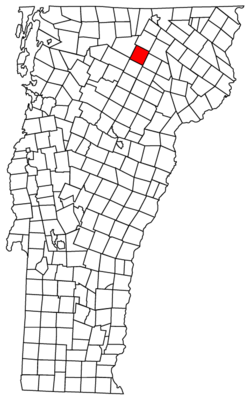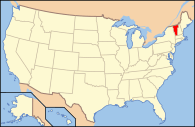Albany, Vermont facts for kids
Quick facts for kids
Albany, Vermont
|
|
|---|---|
|
Town
|
|

Located in Orleans County, Vermont
|
|

Location of Vermont with the U.S.A.
|
|
| Country | United States |
| State | Vermont |
| County | Orleans |
| Chartered | June 26, 1782 |
| Communities |
|
| Area | |
| • Total | 38.7 sq mi (100.2 km2) |
| • Land | 38.5 sq mi (99.7 km2) |
| • Water | 0.2 sq mi (0.5 km2) |
| Elevation | 956 ft (371 m) |
| Population
(2020)
|
|
| • Total | 976 |
| • Density | 25/sq mi (9.8/km2) |
| • Households | 337 |
| • Families | 237 |
| Time zone | UTC-5 (EST) |
| • Summer (DST) | UTC-4 (EDT) |
| ZIP Codes | |
| Area code(s) | 802 |
| FIPS code | 50-00475 |
| GNIS feature ID | 1462024 |
Albany is a small town in Vermont, located in Orleans County. In 2020, about 976 people lived there.
The town of Albany includes four smaller communities. One is the official village of Albany. The others are Albany Center, East Albany, and South Albany.
Contents
History of Albany
How Albany Got Its Name
The land for Albany was first given out on June 26, 1782. It was originally called "Lutterloh." Later, in 1815, the town's name was changed to "Albany."
Albany's Role in the Underground Railroad
Before the Civil War, a person named Rev. George Putnam lived in Albany. He was part of the Underground Railroad. This was a secret network that helped enslaved people find freedom.
Geography of Albany
Land and Water in Albany
Albany covers about 38.7 square miles (100.2 square kilometers). Most of this area, about 38.5 square miles (99.7 square kilometers), is land. The rest, about 0.2 square miles (0.5 square kilometers), is water.
Hills, Rivers, and Ponds
The town of Albany has many hills and uneven areas. The highest point is in the northwest part of the town.
Several streams flow through Albany. Lord's Creek flows north through the eastern part of town. There are also many ponds, like Great Hosmer, Hartwell, Page, Heart, and Duck ponds.
The Black River flows north through Albany Village. It eventually empties into Lake Memphremagog near Newport, Vermont. This river is part of the larger St. Lawrence River system.
Rocks and Soil
The ground in Albany has different types of rocks. You can find talcose schist, limestone, and clay slate. There are also areas with rich soil and some granite rocks.
People of Albany (Demographics)
Population Changes Over Time
| Historical population | |||
|---|---|---|---|
| Census | Pop. | %± | |
| 1800 | 12 | — | |
| 1810 | 101 | 741.7% | |
| 1820 | 253 | 150.5% | |
| 1830 | 683 | 170.0% | |
| 1840 | 920 | 34.7% | |
| 1850 | 1,052 | 14.3% | |
| 1860 | 1,224 | 16.3% | |
| 1870 | 1,151 | −6.0% | |
| 1880 | 1,138 | −1.1% | |
| 1890 | 995 | −12.6% | |
| 1900 | 1,028 | 3.3% | |
| 1910 | 920 | −10.5% | |
| 1920 | 840 | −8.7% | |
| 1930 | 810 | −3.6% | |
| 1940 | 748 | −7.7% | |
| 1950 | 704 | −5.9% | |
| 1960 | 560 | −20.5% | |
| 1970 | 528 | −5.7% | |
| 1980 | 705 | 33.5% | |
| 1990 | 782 | 10.9% | |
| 2000 | 840 | 7.4% | |
| 2010 | 941 | 12.0% | |
| 2020 | 976 | 3.7% | |
| U.S. Decennial Census | |||
In 2000, there were 840 people living in Albany. The population density was about 21.8 people per square mile. Most people living in Albany were White.
Households and Families
There were 337 households in Albany in 2000. About 33% of these households had children under 18. Most households were married couples living together.
The average household had about 2.49 people. The average family had about 2.97 people.
Age Groups in Albany
The population in Albany is spread out across different age groups. About 26% of the people were under 18 years old. About 10% were 65 years or older. The average age in town was 38 years old.
Economy in Albany
Income Information
In 2000, the average income for a household in Albany was $30,625. For families, the average income was $33,750. The average income per person in the town was $15,287.
About 15% of the people in Albany lived below the poverty line. This means their income was below a certain level.
Main Roads in Albany
Cultural Events
In the early 2000s, the Northeast Kingdom Music Festival was held in Albany. This festival had musical performances every year. Only 2000 people were allowed to attend each time.
Notable People
- Willard W. Miles, a judge who served on the Vermont Supreme Court.
See also
 In Spanish: Albany (Vermont) para niños
In Spanish: Albany (Vermont) para niños

